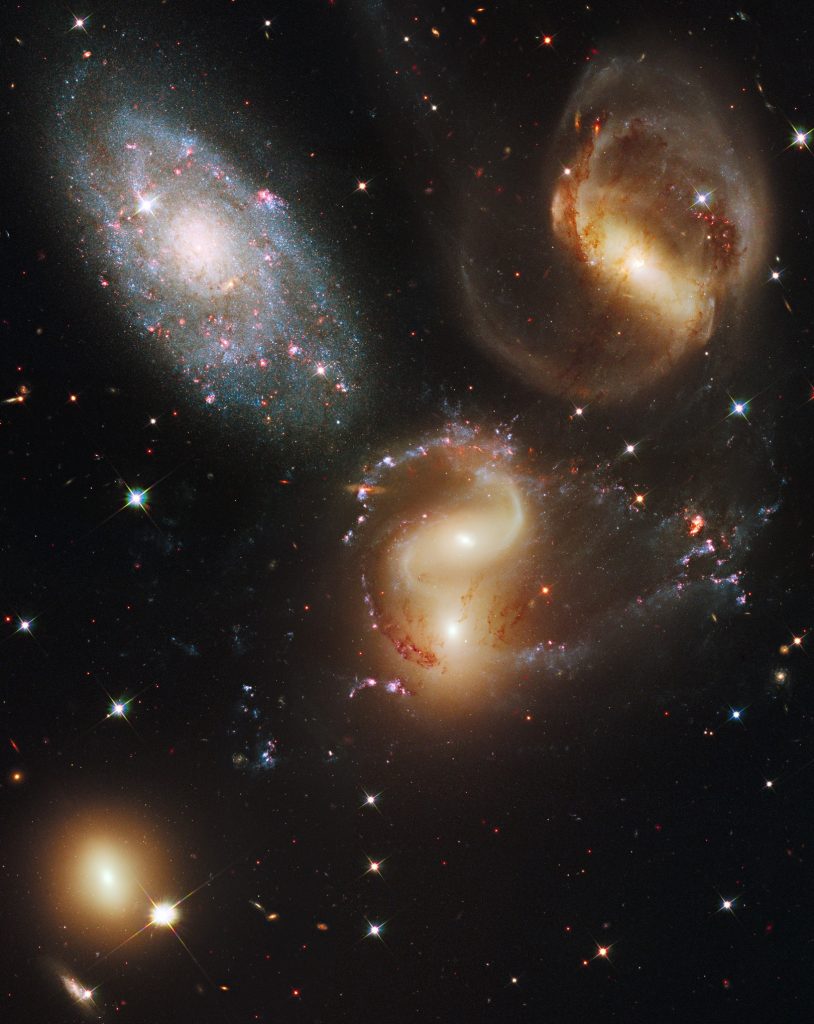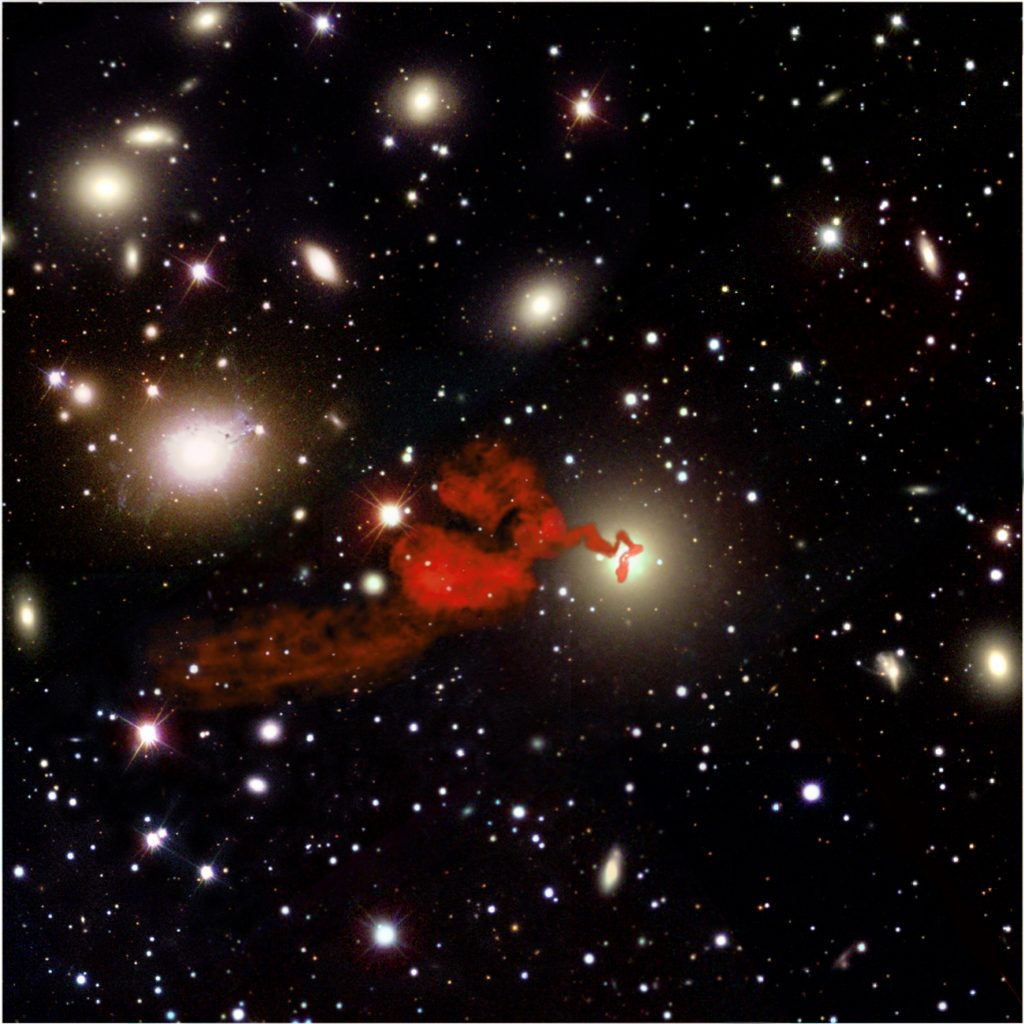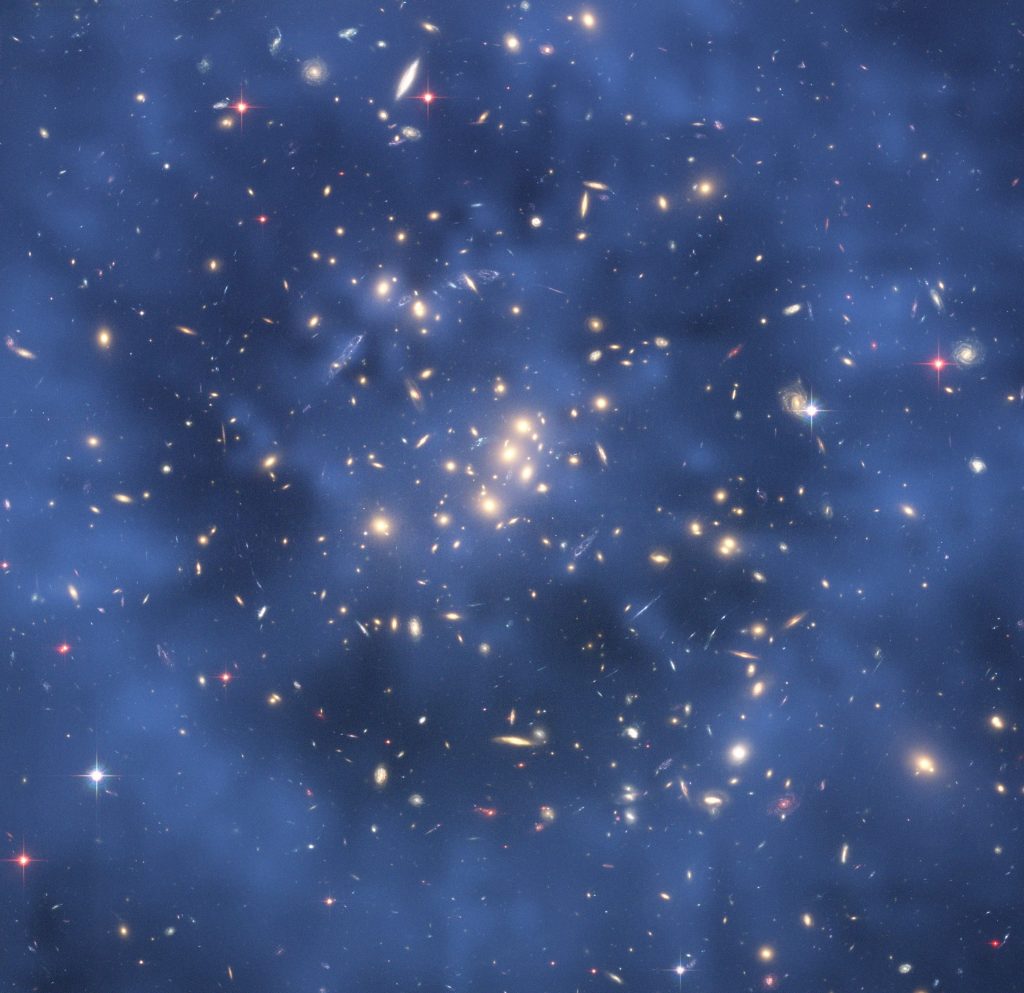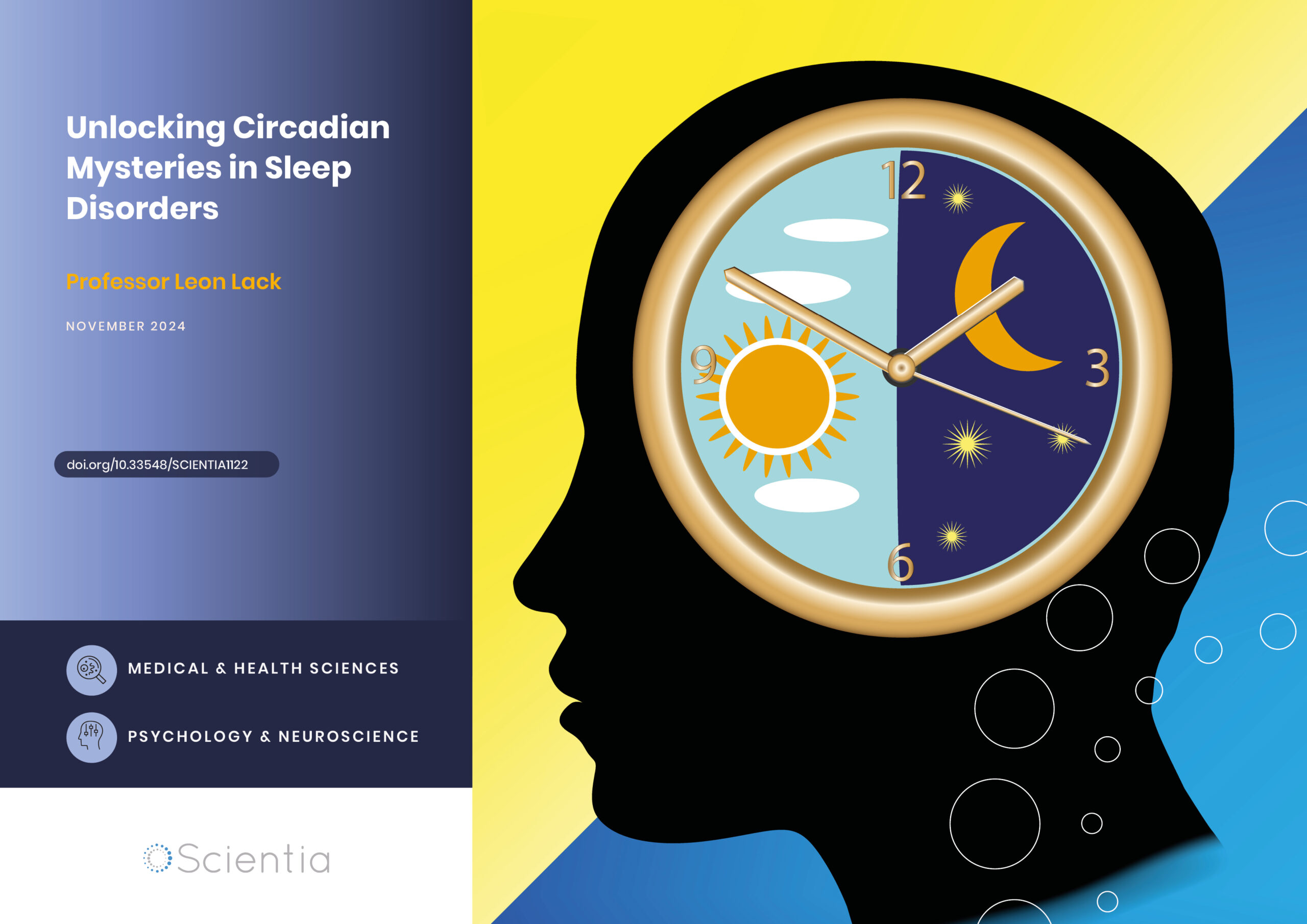Dr Tom Jones – Simulating Flows Between Clustered Galaxies
The spaces in between galaxies may be unimaginably vast, but within galactic clusters, they are far from empty. Rather, these expanses are home to a wide range of interplaying, often violent plasma dynamics. In his research, Dr Tom Jones at the University of Minnesota plans to use cutting-edge computer techniques to simulate these processes – shedding new light on physical properties that have eluded astronomers so far. His team’s research will not only give crucial insights into some of the largest structures in the known universe, but will also capture the public imagination, and inspire a diverse new generation of astronomers.
Galaxy Clusters
The sheer sizes of galaxies are far too vast for our minds to grasp. Our Milky Way alone contains hundreds of billions of stars, and spans 185,000 lightyears in diameter. However, even galaxies are not the largest known structures in the universe.
Around 10 billion years ago, several billion years after they first formed, large groups of galaxies began to cluster together – pulled in to each other by their mutual gravitational attraction. Today, these colossal structures can contain between hundreds and thousands of galaxies. Our own galaxy, for example, forms a small part of the Virgo supercluster – one of roughly 10 million clusters scattered across the known universe.
In the expansive regions between clustered galaxies, there exist stretches of superheated plasma named the ‘intracluster medium’ (ICM), which is heavily influenced by gravitational interactions between galaxies and broadly distributed but invisible ‘dark matter’, whose gravity is so-far, the only known link to other matter. As clusters form, vast amounts of energy are released into the ICM, forcing its plasma to flow in strange and often unpredictable ways. Dr Tom Jones at the University of Minnesota aims to study this diverse range of physical processes – though not by observing them directly, as most astronomers are used to.
Flows in the Intracluster Medium
Shockwaves are a well-known aspect of fluid dynamics. They are often observed on Earth in the form of pressurised air waves named sonic booms, which form as fast-moving aircraft break the sound barrier. We can also readily feel the effects of disorderly flows of fluid named turbulence – experienced when flying a plane through a storm, or rafting down a fast-moving river. On far larger scales, similar effects can arise in the ICM as surrounding galaxies jostle for space within their clusters.
Following decades of observations of the radiation emitted by ICM plasma, astronomers have discovered that shocks and turbulence can form across a vast range of scales within galactic clusters – producing an abundance of unusual shapes and structures. These include vast, stable jets emanating from the centres of galaxies, which mysteriously bend far out into intergalactic space; tails with distinctive ribs and tethers; and rings surrounding interacting spirals of diffuse material. Yet so far, researchers have met significant challenges in interpreting these observations.

CREDIT: NASA, ESA, Hubble
A Tangle of Cross-talk
The complexity of the problem faced by astronomers stems from the secondary effects of plasma flows in the ICM. As they form, these motions generate both magnetic fields, and streams of high-energy protons, atomic nuclei and electrons, named cosmic rays, which each travel far out into space. In turn, both of these effects can influence the dynamics of other plasma flows in the ICM, altering the characteristics of their own magnetic fields and cosmic rays.
Ultimately, these interactions create an intricate web of cross-talk between different structures, which can be incredibly difficult for astronomers to disentangle using their observations alone. This has created a number of difficult questions regarding the formation and evolution of flows in the ICM, which researchers have mostly been unable to answer. So far, therefore, the processes that came to form the jets, tails, and spirals of the ICM have largely remained a mystery.
Setting Out Key Questions
In their proposal, Dr Jones and his colleagues have distilled the problems surrounding ICM observations into three key questions. Firstly, how can astronomers find and trace the structures produced by shocks and turbulence in the ICM, and physically interpret their observations? Secondly, how can they establish the origins of these flows and their secondary effects, and determine how they are connected to each other? And finally, how can they pin down the physical processes that define the interplays between these flows? Finding answers to each of these questions in turn will prove crucial to understanding the underlying physics of galaxy clusters.
Since astronomers ultimately have no control over what they discover as they scan the sky, relying on observations alone is not always the best way to answer these sorts of questions. Instead, Dr Jones and his team have set out an innovative and wide-reaching proposal for a theoretical research program. Their approach will be based on a cutting-edge, high-performance computer simulation toolkit named WENO-WOMBAT: the culmination of years of previous research by Dr Jones and his colleagues. Through their simulations, they will carry out three complementary efforts to answer each of their initial questions.

Optical image from the Sloan Digital Sky Survey of several galaxies in the Perseus Cluster overlaid with the image of the radio jets formed by the massive black hole in one of those galaxies (NGC 1272). These radio jets have been highly deformed as they propagated through the cluster. CREDIT: M.-L. Gendron-Marsolais (ESO), C. L. H. Hull (NAOJ), R. Perley (NRAO); NRAO/AUI/NSF; Sloan Digital Sky Survey.
Capturing Cluster Evolution
WENO-WOMBAT is capable of simulating two particularly important and challenging aspects of the ICM. One of these is ‘magnetohydrodynamics’ – which studies the continually changing magnetic fields generated by electrically conducting fluids, including plasma such as the ICM. In addition, the toolkit can recreate the transport of cosmic rays through intergalactic space.
Dr Jones predicts that using the new WENO-WOMBAT toolkit, these simulated effects will successfully capture for the first time the secondary effects of flows in the ICM. Moreover, the high resolution of the toolkit will simulate flow dynamics on scales of less than 1,000 lightyears – around the diameter of a single galaxy – and also the scales on which key ICM properties, such as electric conductivity are established. This will enable the team to account realistically for the motions of each galaxy in a large cluster, as they pull each other through the ICM by mutual gravitational attraction.
In the first of their proposed complementary efforts, the researchers will use these advanced capabilities to simulate the evolution of the occasionally-violent encounters between ICM flows, and radio galaxies embedded in the ICM. These galaxies contain supermassive black holes in their centres, which emit vast quantities of radio waves from each of their poles – perpendicular to the galaxy’s flat disc. As the techniques and apparatus used by radio astronomers have improved, such galaxies are now being discovered at a growing rate. By better accounting for the energy that they transfer into the ICM, astronomers will be far more well-equipped to determine how different flow structures arise.
Establishing Links
In their second, complementary, proposed effort, Dr Jones and his colleagues will model the physics of ‘synchrotron’ radiation, which is created when extremely fast-moving electrons are accelerated in spiral paths as they pass through magnetic fields. Since this radiation doesn’t depend on the temperature of its source, as is the case for most radiation, it is a powerful probe of intergalactic magnetic fields where plasma is present. Therefore, the researchers hope that the results of their simulations will allow them to determine how strongly this radiation is linked to cosmic ray emissions, as well as dynamics in the ICM.
In their third and final effort, the team will carry out universe-scale magnetohydrodynamics simulations, with the aim of reliably capturing the formation of the ICM structures being studied and their magnetic fields in selected galaxy clusters. This will enable them to better relate the structures observed by astronomers to the dynamical states of individual clusters. It could even allow them to turn back the clock on their evolution, to predict how clusters may have appeared at different stages of the universe’s history. Together, the researchers hope that each of these efforts will lead to crucial new insights into several long-standing mysteries surrounding the formation and evolution of galaxy clusters. However, they are just one of two key pillars of the team’s proposal.

CREDIT: NASA, ESA, MJ Jee and H Ford
Commitment to Public Engagement
Beyond their immense value to astronomers, the simulations produced by WENO-WOMBAT will also be visually striking – creating a unique opportunity for the team to engage the public with cutting-edge research in astronomy. Previously, Dr Jones was part of the team behind the citizen science project Radio Galaxy Zoo, through which the public could look through the images gathered by radio telescopes to identify new galaxies. Extending this role, he will now aim to communicate his team’s research with the help of the University of Minnesota’s Planetarium, and the Bell Museum of Natural History.
Dr Jones and his colleagues hope that a series of live shows at the Planetarium will offer the public a captivating view of the simulations, providing an innovative new way for them to learn about their findings. Combined with further efforts, including public talks and social media outreach, this proposal will give the public unprecedented access to knowledge, and fresh insights into how theoretical physicists carry out their work.
Academic and Public Benefits
As well as public engagement, Dr Jones and his team are also committed to involving graduate and undergraduate students from a diverse range of backgrounds – including groups that are currently under-represented in astronomy research.
Ultimately, their proposal combines public and academic efforts to create opportunities for a new generation of aspiring astronomers, with ground-breaking theoretical techniques that will fill in the gaps left by as-yet unexplained observations. Their plans represent a model approach to how science can be best carried out in the landscape of modern research.
Reference
https://doi.org/10.33548/SCIENTIA649
Meet the researcher

Dr Thomas W. Jones
School of Physics and Astronomy
University of Minnesota
Minneapolis, MN
USA
Dr Tom Jones completed his PhD in Physics at the University of Minnesota in 1972. After graduation, he worked as a scientist at University of California, San Diego, followed by the National Radio Astronomy Observatory in West Virginia. In 1978, he returned to the University of Minnesota, where he became a Professor at the School of Physics and Astronomy. His research interests lie in theoretical and computational astrophysics, which involve the study of phenomena including cosmic rays, supernova remnants, active galactic nuclei, and galaxy clusters. In his most recent research, Dr Jones has focused on using numerical simulations to understand how magnetic structures affect flows of plasma and cosmic rays. These efforts have led significant new developments in computer codes for astrophysical simulations.
CONTACT
E: twj@umn.edu
W: https://cse.umn.edu/physics/thomas-w-jones/
KEY COLLABORATORS
Dr Lawrence Rudnick, University of Minnesota
Dr Peter Mendygral, Amazon Web Services
Dr Dongsu Ryu, Ulsan National Institute of Science and Technology, Republic of Korea
Dr Hyesung Kang, Pusan National University, Republic of Korea
FUNDING
US National Science Foundation
FURTHER READING
ML Gendron-Marsolais, CL Hull, R Perley, L Rudnick, R Kraft, J Hlavacek-Larrondo, AC Fabian, E Roediger, RJ van Weeren, A Richard-Laferrière, E Golden-Marx, VLA resolves unexpected radio structures in the Perseus cluster of galaxies, 2021 arXiv preprint, arXiv:2101.05305.
J Donnert, H Jang, P Mendygral, G Brunetti, D Ryu, T Jones, WENO-WOMBAT: Scalable Fifth-order Constrained-transport Magnetohydrodynamics for Astrophysical Applications, Astrophysical Journal Supplements, 2019, 241, 23.
T Jones, C Nolting, B O’Neill, P Mendygral, Using Collisions of AGN outflows with ICM shocks as dynamical probes, 2017, Physics of Plasmas, 24, Issue 4, 041402.

Want to republish our articles?
We encourage all formats of sharing and republishing of our articles. Whether you want to host on your website, publication or blog, we welcome this. Find out more
Creative Commons Licence
(CC BY 4.0)
This work is licensed under a Creative Commons Attribution 4.0 International License. 
What does this mean?
Share: You can copy and redistribute the material in any medium or format
Adapt: You can change, and build upon the material for any purpose, even commercially.
Credit: You must give appropriate credit, provide a link to the license, and indicate if changes were made.
More articles you may like
Professor Aristides Marcano Olaizola | Innovation in the Production of Singlet Oxygen
A novel method for producing singlet oxygen via stimulated Raman scattering (SRS) offers an innovative alternative to traditional photosensitizer-based techniques, promising safer and more efficient applications in disinfection, cancer treatment, and beyond. Professor Aristides Marcano Olaizola at Delaware State University is driving innovation in this critical field.
Dr Marta Berrocal-Lobo | Unlocking the Potential of Essential Oils: Illuminating Epigenetic Effects on Plant Defense Mechanisms
Essential oils (EO) are potent in enhancing plant stress responses and mitigating seed-borne diseases, particularly in high-value crops such as tomatoes. While their direct impacts are recognised, the indirect influences on plant growth, metabolism, and immune responses against phytopathogens remain uncertain. Dr Marta Berrocal-Lobo, an esteemed Associate Professor and researcher at the Polytechnic University of Madrid, in collaboration with the Group of Biopesticides led by Dr Azucena Gonzalez-Coloma, is unravelling the transcriptomic and metabolic responses of tomato seeds treated with an antifungal EO against the pathogen Fusarium oxysporum sp. Their findings pave the way for harnessing EO in sustainable agriculture.
Dr Linda Hammerich | Revolutionising Immune Monitoring with Flow Cytometry
Understanding the individual immune response is key to diagnosing and treating a range of diseases. One way of characterising immune cells is through flow cytometry, where cells are tagged with fluorescent markers known as fluorochromes. Detectors use these markers to understand the different physical and chemical features of the individual cells and the overall immune cell population. Dr Linda Hammerich and a team from Charité-Universitätsmedizin in Germany have optimised this technique to investigate up to 31 different cells or markers from one blood test using currently available technology.
Dr Leon Lack | Unlocking Circadian Mysteries in Sleep Disorders
Sleep disorders can significantly disrupt daily life, but their underlying causes are not always clear. Dr Leon Lack from Flinders University has spent decades studying these disorders and how to treat them. By shedding light on the role of circadian rhythms in delayed sleep-wake phase disorder and non-24-hour sleep-wake rhythm disorder, he hopes to unravel why some people struggle to maintain conventional sleep patterns and could lead to more effective treatments for these challenging conditions.




